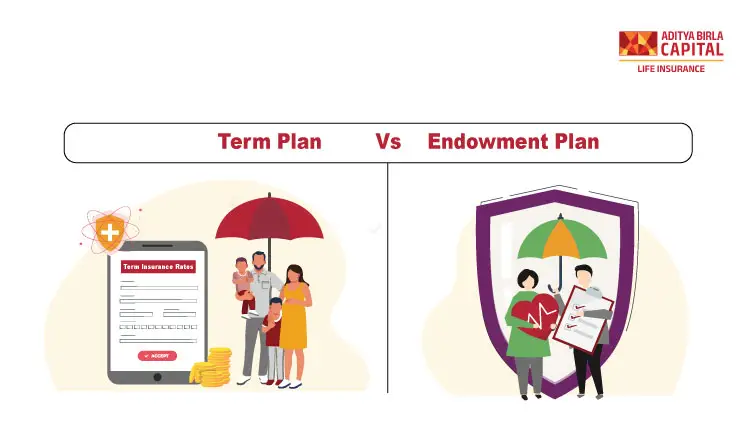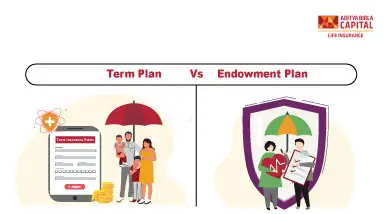Recognising your loved ones' financial requirements is the very first step toward protecting their future. It allows you to determine which investment plan or insurance policy will provide you with optimal outcomes in a given circumstance. Choosing between a term insurance policy and an endowment policy is a typical worry among consumers.
As a result, comprehensive endowment plan vs term plan comparison might be beneficial. Let’s understand both, term plan and endowment plan!
What is Term Insurance?
Term insurance policy is one of the most well-known forms of life insurance coverage. It is a straightforward insurance plan that provides the insured with long-term life cover. It is entirely dependent on the policyholder to determine the policy 'term' for which the life insurance is required.
If the insured dies within the policy term, the beneficiary is eligible for a death payout. The sum assured amount payable is decided when the term insurance plan is purchased. Term insurance policy is often regarded as being one of the economic kinds of life insurance plans. In order to keep the coverage effective, you must pay a premium on a regular basis, like with other insurance plans.
It should be noted that a simple term insurance plan only provides a death payout. It indicates that if the insured survives the policy period, no survival benefit is provided.
Difference between term plan and endowment plan
If you’re looking for an endowment insurance vs term insurance comparison, don’t fret! Here are the major differences between term insurance and endowment plans:
|
Particulars
|
Term Life Insurance
|
Endowment Plans
|
|
Objectives Served
|
Life coverage
|
Life coverage plus savings
|
|
Plan Coverage
|
Only life insurance coverage is offered
|
Life insurance coverage along with wealth creation
|
|
Sum Assured
|
Comparatively higher
|
Comparatively lower
|
|
Premium Rates
|
Comparatively lower
|
Comparatively higher
|
|
Policy Maturity Benefit
|
No maturity benefit is provided
|
A part of the sum assured along with any relevant bonus amount is provided as maturity benefit
|
|
Policy Payout Modes
|
Lump-sum or monthly instalments
|
Lump-sum
|
|
Add-ons
|
Add-ons and riders are available
|
Add-ons and riders are available
|
|
Tax Breaks3
|
Section 80C offers tax deduction of up to a limit of INR 1.5 lakhs on life insurance premiums paid. Section 10 (10D) makes maturity and death benefit amounts tax-free, given certain conditions are fulfilled.
|
Section 80C offers tax deduction of up to a limit of INR 1.5 lakhs on life insurance premiums paid. Section 10 (10D) makes maturity and death benefit amounts tax-free, given certain conditions are fulfilled.
|
|
Pre-mature Cash Withdrawal
|
Cash withdrawal is not allowed.
|
Cash withdrawal is allowed after some years in case of an emergency.
|
Now that you’ve gone through the endowment policy vs term policy comparisons, here’s something to note. The majority of insurance providers offer both term life and endowment insurance plans. The premium rate for the amount of guaranteed4 sum assured varies per insurance company. Both scenarios qualify for tax advantages under Section 80C of the Income Tax Act.
How to Choose Between Term Insurance & Endowment Plan?
Now, if you are confused, here are some pointers to help you make an educated decision.
1. Financial Objective
Every individual has different life expectations for a variety of factors. The type of lifestyle you follow, the number of financial obligations you have, and your requirements are all frequent aspects that have a significant impact on your life. It's in your best financial interest to plan out your needs so that you may make an informed decision regarding term insurance versus an endowment plan. Consider if an insurance cover, investment plan, or a mix of the two will provide you with the best long-term outcomes.
2. Ongoing and Future Expenses
There are several costs that you must handle on a daily basis in life. The price of living is continually growing, which is why compounding savings is critical for meeting future demands. You can compare the appropriateness of term life insurance versus an endowment life insurance plan based on the costs you have to handle with your salary.
3. Affordability
Due to the differences in coverage, the price of acquiring term insurance versus an endowment plan differs. You can determine which one is better for you by thoroughly examining your financial situation. It will also assist you in determining whether either policy's amount insured is adequate for your household. If you overestimate the sum assured, you may be unable to maintain the insurance in effect. As a result, you risk losing significant funds and advantages from an insurance policy or investment vehicle.
Term insurance plans should not be disregarded because they are the simplest type of insurance, giving coverage against life's greatest reality - death. You can choose endowment programs for the sole aim of investing, and you will be economically solvent for the rest of your lifetime. It is impossible to choose between Term Life Insurance and Endowment Life Insurance plans because each has its unique importance. Purchase a term plan to safeguard your dependents against early death, as well as an endowment plan for future income production or pension after retirement.
The Bottom Line
The truth is that both term insurance and endowment policies are important for your financial future, but the analysis of financial protection their assets can provide you with will depend on the nature of your financial situation and objectives. Ultimately, a composite rating of the two plans' benefits and drawbacks can tell you which policy is most appropriate for your personal situation. Term insurance and endowment plan comparisons can be beneficial to your financial future. Weighing each option will allow you to recognise how best to help your family in the event of your death.










